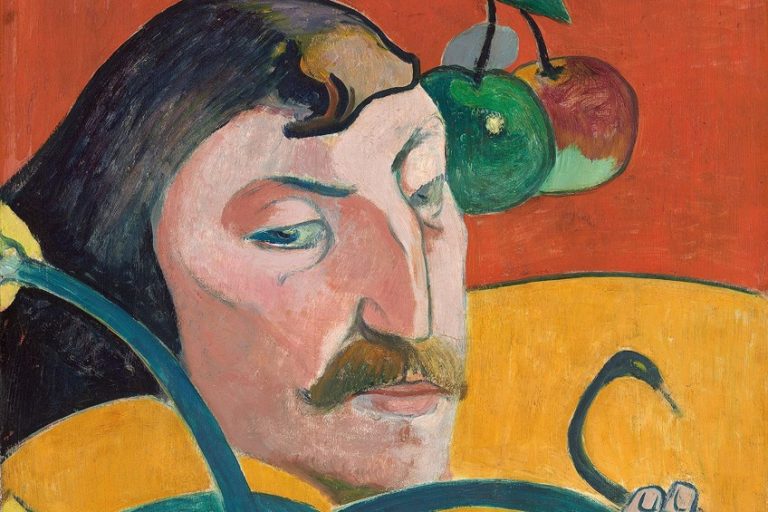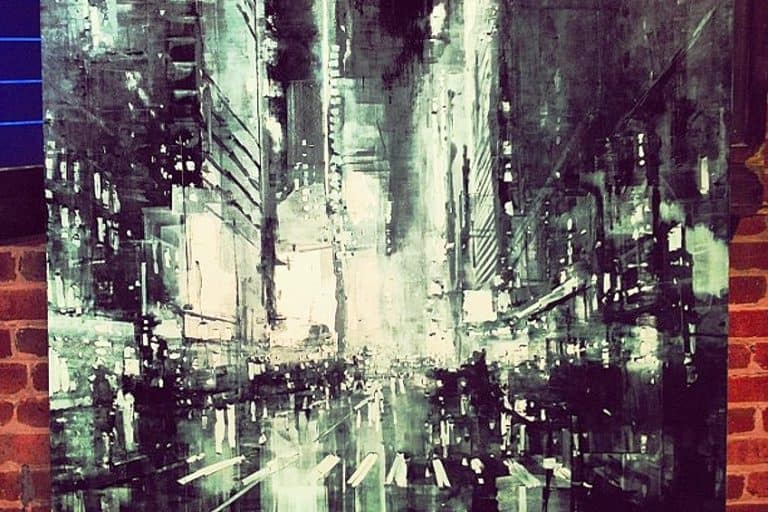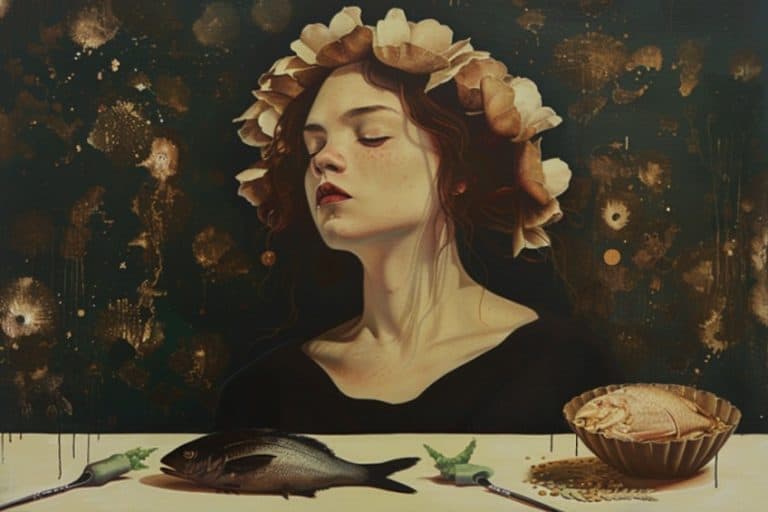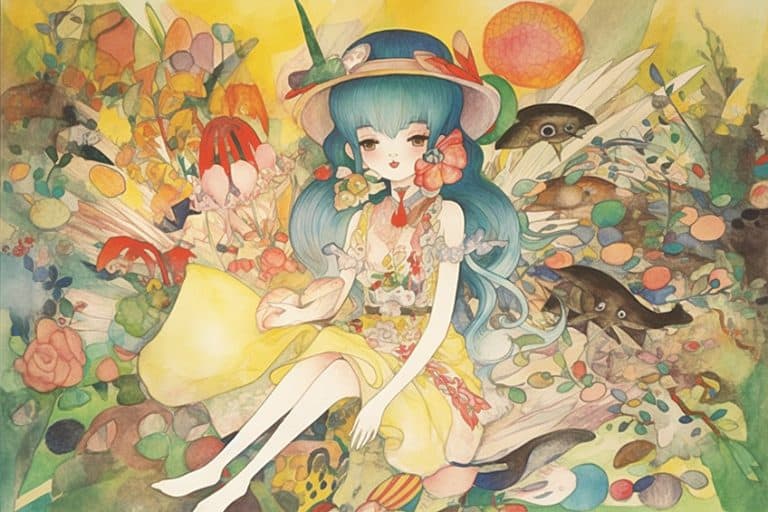Raoul Dufy – A Master of French 20th Century Art
Raoul Dufy, a prominent figure in early 20th-century French art, was renowned for his vibrant and expressive paintings that captured the essence of modern life. Born in Le Havre in 1877, Dufy’s artistic journey led him to embrace Fauvism’s bold colors and later transition into a distinctive style characterized by fluid lines and a sense of movement. His works often depicted scenes of leisure, bustling cityscapes, and the natural world, infused with a joyful energy that continues to captivate audiences worldwide.
Key Takeaways
- Raoul Dufy is recognized for his role in the Fauvist movement and his vibrant, decorative style.
- His journey in the arts encompassed training in Paris and a transition from Impressionism to Fauvism.
- Dufy’s legacy is preserved through his wide-ranging creative endeavors, spanning painting, textile design, and more.
Early Life and Education
| Birth | June 3, 1877 |
| Death | March 23, 1953 |
| Place of Birth | Le Havre, France |
| Genre of Work | Fauvism, Impressionism, Modernism, and Cubism |
Raoul Dufy was a prominent French painter whose work played a pivotal role in the development of the Fauvist movement. Born in France, Dufy’s unique approach to art was recognized for its vibrancy and decorative quality, which found avenues of expression across a plethora of mediums beyond canvas, including textile designs and public decorations. His rich tapestry of creative output left a mark on the way festive and leisure scenes are depicted, making him an emblematic figure in the transition to modernist aesthetics.

Dufy’s artistic journey began in earnest when he moved to Paris in 1900 to study at the École des Beaux-Arts. Initially influenced by impressionism, he soon incorporated Fauvism’s characteristic bold brushstrokes and striking palettes into his work. Despite the transformation in his style, Dufy remained true to his passion for portraying scenes of luxury and recreation, thus solidifying his distinctive place within the art world.
His creations extended to scenarios of yachting, racing, and musical events, each characterized by an infectious sense of joy and bold contours.
Le Havre and Artistic Beginnings
Born on June 3, 1877, in Le Havre, Normandy, Raoul Dufy was introduced to the world of art at an early age. This bustling port city served as his first canvas, where he drew initial inspiration and recognized his inclination towards art. Le Havre was not only Dufy’s birthplace but also the crucible of his formative years as an artist. At the age of 14, he made the decisive pivot from general education to dive into the art world, initially balancing work with a coffee-importing company and his burgeoning artistic education.
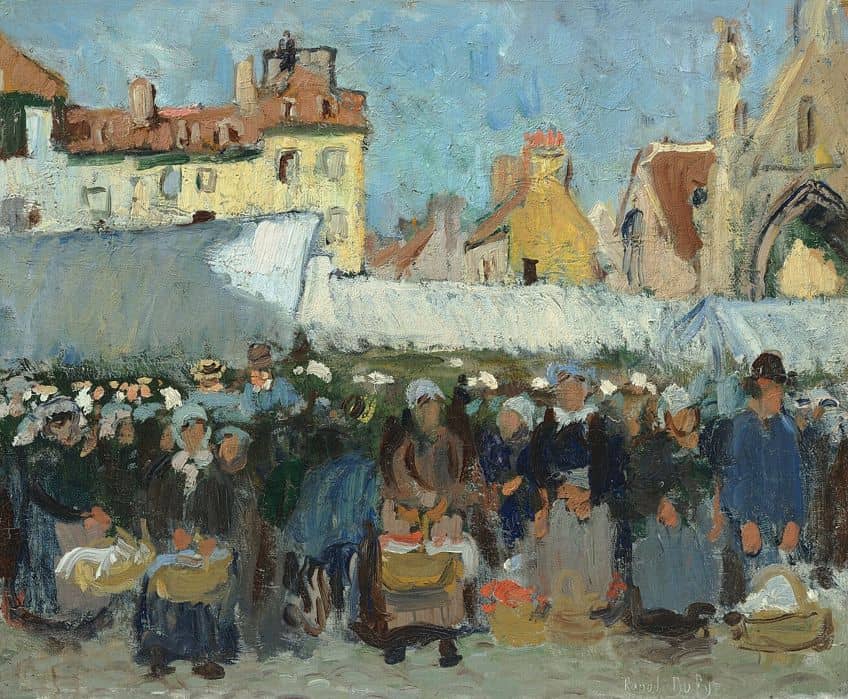
Charles Lhuillier, a respected former student of the eminent French portrait painter Ingres, saw potential in Dufy and mentored him at the École des Beaux-Arts in Le Havre. Here, Dufy began developing his foundational skills, absorbing the traditional principles that would underpin his evolution as an artist.
École des Beaux-Arts and Influence
In 1895, at 18 years old, Raoul Dufy deepened his formal art training by attending evening classes at the École des Beaux-Arts in Le Havre. His education was influenced significantly by professors like Charles Lhuillier and Raimond Lecourt, who provided him with rigorous guidance in the arts. Their teachings helped Dufy establish a solid academic grounding.
Dufy’s time at the École des Beaux-Arts coincided with his exposure to the works of Paul Cézanne. Cézanne’s approach to form and color left an indelible imprint on Dufy’s style. As he found his voice in the art world, Dufy absorbed the emerging trends of the time, which hinted at the trajectory his career would take. Upon completing his studies in Le Havre, Raoul Dufy decided to relocate to Paris, where he attended the national École des Beaux-Arts.
It was there, amidst the artistic fervor of Montmartre, that Dufy’s distinctive style began to take shape, influenced by the avant-garde movements that were sweeping the Parisian art world at the turn of the 20th century.
Artistic Style and Development
Raoul Dufy’s contributions to art are marked by his vivid use of color and dynamic decorative style that evolved across different mediums from painting to textile designs.

Fauvism and Color
Initially influenced by Impressionism, Dufy’s style underwent a significant transformation after he encountered the work of Henri Matisse. Dufy embraced Fauvism, a movement characterized by bold colors and painterly qualities. His Fauvist period is distinguished by the use of bright, expressive colors and simplified forms.
This approach allowed him to convey emotions vividly and went on to define much of his early work.
Development Beyond Fauvism
While Fauvism was pivotal in Dufy’s artistic development, he was not confined by it. His exploration of color extended to a personal style that included elements of Cubism, as seen in his structured compositions that sometimes echoed the work of Georges Braque and Paul Cézanne. Over time, his style became freer and more dynamic, as he incorporated broader brushstrokes and a more diverse color palette.

Public and Decorative Art
Dufy’s decorative style lent itself to large-scale public projects and planning public spaces. He completed murals for public buildings, where he implemented elements of allegory and mythology.
His designs extended to various mediums beyond traditional paintings and drawings, including ceramics, furniture, and scenic designs for public celebrations and events.
Accomplishments
Notably, Dufy’s accomplishments include his impact on textile design and involvement in the Salon des Indépendants, an exhibition that fostered avant-garde ideas. His artwork often featured scenes of leisure, manifesting a sense of enjoyment and luxury. Dufy’s versatility and his ability to cross traditional boundaries between fine and applied arts, contributed to his recognition not just as a painter but also as a designer of textiles and a planner of public spaces.

Major Works and Collaborations
Raoul Dufy, a multi-faceted artist known for his vibrant and colorful works, made significant contributions across various artistic domains. His partnerships, notably with Paul Poiret, and his diverse repertoire in painting, textiles, and public commissions have cemented his place in art history. Raoul Dufy’s paintings are celebrated for their exuberance and lively depiction of leisurely scenes. Among his most prominent works is La Fée Electricité, a masterpiece created for the 1937 Paris International Exposition.
This large mural showcases Dufy’s eclectic use of color and energetic brushwork.
Illustration, Ceramics, and Textile Design
As an illustrator and designer, Dufy’s collaboration with the fashion designer Paul Poiret was pivotal. He adapted his expressive style to create graphic patterns for textiles, fusing fine art with the fashion world. Dufy’s role as a designer demonstrates his versatility and his influence beyond the canvas. Beyond painting and textiles, Dufy extended his creativity to the realm of ceramics and tapestries. His work as a ceramicist and printmaker involved vibrant watercolors and allowed him to experiment with different materials and techniques.

Public Commissions
Dufy’s decorative flair is evident in his public commissions, which include design schemes for municipal buildings and other public spaces. Here, his art served not only an aesthetic purpose but also contributed to cultural and community landmarks.
In offering an array of artworks across several mediums, Raoul Dufy stood out as a talented painter, designer, illustrator, and ceramicist whose broad legacy continues to be appreciated.
Legacy and Influence
Raoul Dufy’s vibrant approach and his role in the Fauvist movement have had a lasting impact on modern art, recognized in museums worldwide and continuing to inspire artists today.
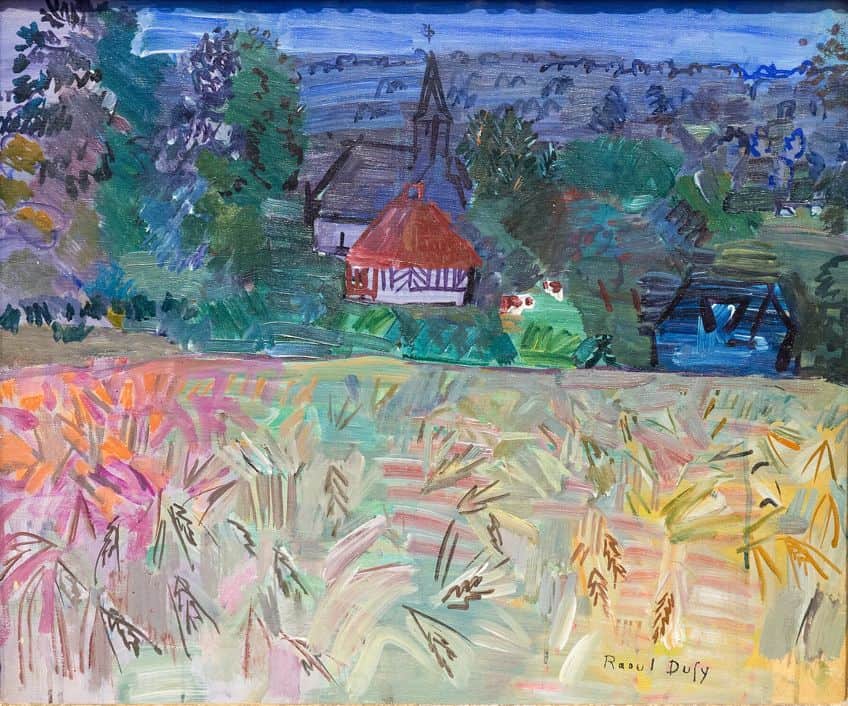
Influence on Modern Art
Raoul Dufy’s contribution to Fauvism, characterized by its use of bold colors and expressive brushwork, significantly influenced the development of modern art. His style was unique in its application of playful and vivid scenes, often depicting pleasure, including regattas and outdoor social gatherings. Dufy’s influence extended beyond traditional canvas work; his dynamic approach also revolutionized textile design and book illustration.
He painted Norman landscapes and maritime scenes vistas of the English Channel, or La Manche, infusing them with a lightness and joy that echoed the leisure pursuits he captured.
Recognition and Museums
Dufy’s works are widely recognized in the art world and have been showcased in prestigious exhibitions over the years, including the Venice Biennale. His relationship with influential art patrons such as Gertrude Stein helped to cement his place in art history. Museums across the globe carry Dufy’s legacy, with permanent collections featuring a range of his artworks, from oils to etchings. Key pieces of Dufy’s work can be found in the Museum of Modern Art in New York and the Musée d’Art Moderne in Paris, ensuring that his contribution to Fauvism and art at large remains accessible to the public.
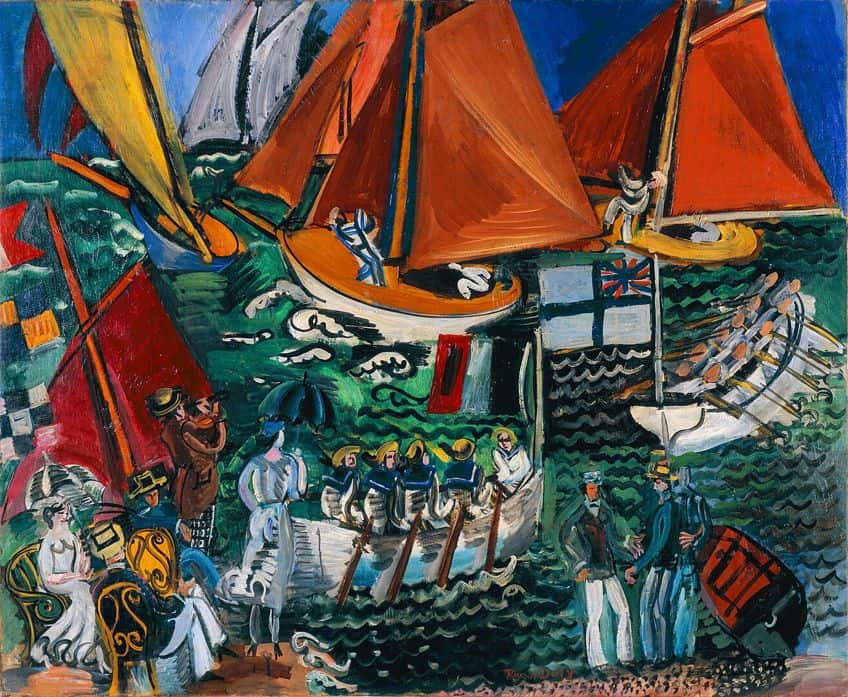
Legacy of Raoul Dufy Today
The artistic legacy of Raoul Dufy persists in various facets of contemporary art and design, resonating with a new generation of artists and designers. His brother, Jean Dufy, also an artist, continued the aesthetic values and themes consistent with Raoul’s vision. Influences from his mentorship under painter Camille Pissarro and contemporary Maurice Denis are evident in his work. Additionally, Dufy’s connection with art dealers like Berthe Weill played a significant role in the enduring presence of his art in modern discourse. The town of Forcalquier, where he passed away, remains a testament to Dufy’s life, attracting visitors and scholars alike who seek to delve into the artist’s rich history and enduring influence.
Raoul Dufy’s legacy as an artist endures through his dynamic and colorful contributions to the art world. His ability to capture the spirit of modernity, coupled with his unique style and mastery of color, cements his place among the influential artists of the 20th century. Dufy’s works continue to inspire and delight art enthusiasts, showcasing his enduring impact on the visual arts landscape.
Frequently Asked Questions
What Are the Defining Characteristics of Raoul Dufy’s Painting Technique?
Raoul Dufy is known for his vibrant, colorful approach that aligns with the Fauvist movement. His use of bold, expressive colors and free-form brushwork emphasize lightness and spontaneity, making his work easily distinguishable.
Where Can I Find and View Raoul Dufy’s Artwork?
Dufy’s paintings are displayed in major art museums around the world, including the Museum of Modern Art in New York. His works are part of many public and private collections, offering various opportunities for admirers to view his art.
What Is the Value Range for Raoul Dufy’s Original Paintings?
The value of Raoul Dufy’s original paintings varies significantly based on factors such as provenance, medium, size, and subject matter. Auction prices can range from thousands to well over a million dollars, reflecting his status in the art market.
Isabella studied at the University of Cape Town in South Africa and graduated with a Bachelor of Arts majoring in English Literature & Language and Psychology. Throughout her undergraduate years, she took Art History as an additional subject and absolutely loved it. Building on from her art history knowledge that began in high school, art has always been a particular area of fascination for her. From learning about artworks previously unknown to her, or sharpening her existing understanding of specific works, the ability to continue learning within this interesting sphere excites her greatly.
Her focal points of interest in art history encompass profiling specific artists and art movements, as it is these areas where she is able to really dig deep into the rich narrative of the art world. Additionally, she particularly enjoys exploring the different artistic styles of the 20th century, as well as the important impact that female artists have had on the development of art history.
Learn more about Isabella Meyer and the Art in Context Team.
Cite this Article
Isabella, Meyer, “Raoul Dufy – A Master of French 20th Century Art.” Art in Context. May 20, 2024. URL: https://artincontext.org/raoul-dufy/
Meyer, I. (2024, 20 May). Raoul Dufy – A Master of French 20th Century Art. Art in Context. https://artincontext.org/raoul-dufy/
Meyer, Isabella. “Raoul Dufy – A Master of French 20th Century Art.” Art in Context, May 20, 2024. https://artincontext.org/raoul-dufy/.





